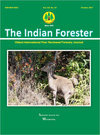Population Distribution of Indian Giant Squirrel Ratufa indica in Dry and Moist Deciduous Forest of Sironcha forest Division, Central India
DOI:
https://doi.org/10.36808/if/2017/v143i10/119355Keywords:
Indian Giant Squirrel, Ratufa indica, Nesting, Population, Sironcha Forest Division.Abstract
Distribution of the Indian Giant squirrel (IGS), Ratufa indica population was studied in the moist deciduous, dry deciduous forest and moist evergreen forests of Sironcha Forest Division, Maharashtra, India. A total of 2803 nests of IGS were observed including 1533 nests used by the species suggesting 256 individuals. The nests were distributed in clusters and 39% of them occurred in 5 clusters. The nest density ranged between 0.5 and 42.7 km2. Amongst 98 tree species recorded in the area, IGS used 49 species for nest building. IGF build around 71% of its nests on nine tree species. The most preferred tree species was Xylia xylocarpa followed by Terminalia alata, Anogeissus latifolia and Madhuca longifolia. Evergreen trees were preferred for nest building as compared with deciduous trees. The data suggests that even good quality forests with close canopy and high biodiversity are devoid of sizeable IGS population.References
Agarwal V.C., Chakraborty S. (1979). Catalogue of mammals in the Zoological Survey of India, Rodentia, Part I – Sciuridae. Records of Zoological Survey of India, 74:333–481.
Baskaran B., Venkatesan S., Mani J., Srivastava S.K. and Desai A.A. (2011). Some aspects of the ecology of the Indian Giant Squirrel Ratufa indica (Erxleben, 1777) in the tropical forests of Mudumalai Wildlife Sanctuary, southern India and their conservation implications, J. Threatened Taxa, 3(7):1899–1908.
Borgis R. and Rao M.K. (2014). The Indian Giant Squirrel. Pune Wild life division. Maharashtra Government. 88pp.
Champion H.G. and Seth S.K. (1968). A revised survey of forest types of India, Govt. of India Press, New Delhi, 404pp.
Corbet G.B. and Hill J.E. (1992). Mammals of the Indomalayan region. A systematic review. Oxford University Press, Oxford, 488pp.
Datta A. (1993). Space-use patterns of the Indian giant squirrel (Ratufa indica) in relation to food availability in Bori Wildlife Sanctuary, Madhya Pradesh, India. M.Sc. thesis, Saurashtra University.
Datta A. (1998). Anti-predatory response of the Indian giant squirrel Ratufa indica to predation attempts by the Crested Hawk Eagle Spizaetus cirrhatus limnaetus, J. Bombay Natural History Society, 95: 332–335.
Datta A. (1999). Daytime resting in the nest – An adaptation by the Indian giant squirrel Ratufa indica to avoid predation, J. Bombay Natural History Society, 96:132–134.
Datta A. and Goyal S.P. (1996). Comparison of forest structure and use by the Indian giant squirrel (Ratufa indica) in two riverine forests of central India, Biotropica, 28(3):394–399.
Gurjar R.L., Kumbhar A.S., Jena J., Yogesh J.K., Dave C., Singh R.P. and Mishra A. (2014). Population density of Indian giant squirrel Ratufa indica centralis (Ryley, 1913) in Satpura National Park, Madhya Pradesh, India. J. Research in Biology, 3(7):1086-1092.
Jathana D., Kumar N.S. and Karanth K.U. (2008). Measuring Indian giant squirrel (Ratufa indica) abundance in southern India using distance sampling. Special editing: Arboreal squirrel. Current Science, 95(7): 885–888.
Kanoje R.S. (2008). Nesting site of Indian Giant Squirrels in Sitanadi Wildlife Sanctuary, India, Current Science, 95(7):882-884.
Koprowski J.L. and Nandhini R. (2008). Global hotspots and knowledge gaps for tree and flying squirrels. Current Science, 95(7): 851-856.
Kumara H.N. and Sing M. (2006). Distribution and relative abundance of giant squirrels and flying squirrels in Karnataka, India. Mammalia, 70:40–47.
Madhusudan M.D. and Karanth K.U. (2000). Huntingfor an Answer: Is Local Hunting Compatible with Large Mammal Conservation in India? In: Hunting for Sustainability in Tropical Forests (J.G. Robinson and E.L. Bennett, eds). New York: Columbia, University Press.339-355 pp.
Mehta P. (1997). Leopard (Panthera pardus) attempting to prey on Indian giant squirrel (Ratufa indica centralis). J. Bombay Natural History Society, 94: 555.
Mehta P., Kulkarni J., Pawar T., Sahoo R.K., Arulmalar E. and Punjabi G. (2012). Status and Distribution of Malabar Giant Squirrel Ratufa Indica in Westen Ghat of Maharashtra, India, Wild Life Research Conservation Society, Pune. Final Technical Report submitted to WWF New Delhi and Ruffords small Grants Programme, United Kingdom, 74pp.
Nayak B.K. and Patr A.K. (2015). Feeding and nesting ecology of Indian giant squirrel Ratufa indica (Erxleben, 1777) in Kuldiha wildlife sanctuary, Balasore, Odisha, India and its conservation. Inter. J. Bioassays, 4 (03): 3741-3746.
Prachi M., Kulkarni K., Pawar T., Sahoo R.K., Arulmalar E. and Punjabi G. (2012). Status and distribution of Malabar Giant Squirrel Ratufa indica in Western Ghats of Maharashtra, Wildlife Research and Conservation Society, Pune. Final Technical Report submitted to WWF New Delhi and Ruffords Small Grants Program, United Kingdom. pp74.
Prakash S., Mishra A.K. and Raziuddin M. (2011). Studies on the nesting habits of Indian giant squirrel. Ratufa indica centralis Ryley 1913 in Dalma wildlife. Sanctuary, Jharkhand, India. Columban J. Life Science, 12(1/2): 9-18.
Ramachandran K.K. (1988). Ecology and behavior of Malabar Giant Squirrel Ratufa indica maxima (Schreber) 1788, Report of the Project Wild 04/83. Division of Wildlife Biology, Kerala Forest Research Institute, Peechi, Kerala, 47.9.
Ramachandran K.K. (1992). Certain aspects of ecology and behavior of Malabar Giant Squirrel Ratufa indica. (Schreber). Ph.D. Thesis, University of Kerala, 191pp.
Roberts N.J. (2011). Investigation into survey techniques of large mammals: surveyor competence and camera-trapping vs. Transectsampling. Bioscience Horizons, 4 (1): 40-49.
Rout S.D. and Swain D. (2005). Status of Giant Squirrel (Ratufa indica) in Similipal Tiger Reserve, Orissa, India. Indian Forester, 131(10):1363–1372.
Srinivas V., Venugopal P.V. and Ram S. (2008). Site occupancy of the Indian Giant Squirrel Ratufa indica (Erxleben) in Kalakad-Mundanthurai Tiger Reserve, Tamil Nadu, India. Special editing: Arboreal squirrel, Current Science, 95(7):889–894.
Tiwari S.K. (2002). Tribal Roots of Hinduism. Sarup & Sons, 333pp.
WWF (2000). counting wildlife manual. wildlife management series. 49 pp.
Downloads
Downloads
Published
How to Cite
Issue
Section
License
Unless otherwise stated, copyright or similar rights in all materials presented on the site, including graphical images, are owned by Indian Forester.





